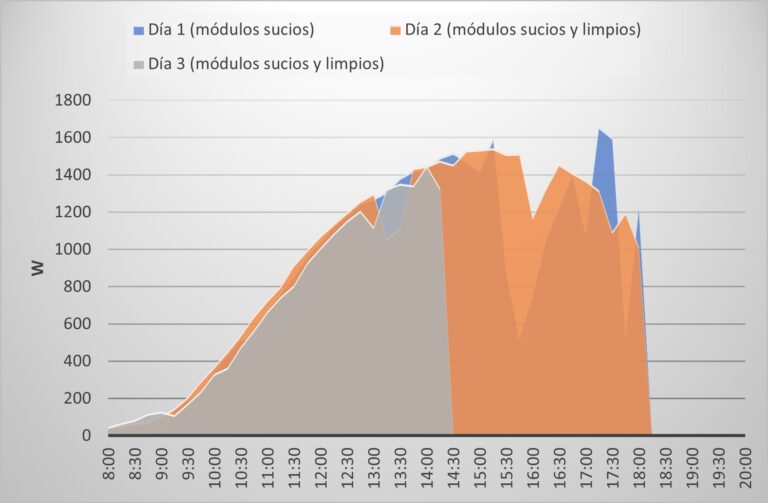A few days after the start-up of our laboratory, and after the arrival of a batch of several microinverters, in Pebblex We have not been able to stand the desire and we have started with our first tests.
Table of Contents
How does dirt affect the production of solar panels?
With the installation at 90%, the modules have been outdoors for almost 3 months (with the connectors covered to prevent any oxidation, of course) and have supported both the work on our building and the work on a future residential building located opposite ours on the same street. All this has caused an accumulation of dirt in the modules higher than normal.
Having microinverters to test on one side, and modules with a lot of dirt on the other, there was no other option but to do the following:


These 6 modules Recom Lion 390 W model with HJT technology have been connected to 500, 800 and 1800 W microinverters.
The 500 W inverter has one input/output, the 800 W inverter has 2, and the 1800 W inverter has 4. Each output of each inverter has its own MPPT, so we can have up to 7 strings with this setting.
However, We have only connected the first 5 modules that appear in the image. We have not been able to connect the remaining 2 due to the length of the default conductors of the modules (Issue that can cause more than one headache for installers in case of installations with microinverters with several inputs and not including these modules with long enough conductors).
We decided to take data one day with all the dirty modules and the next day to clean 3 of them and check differences. The layer of dirt should cause a reduction in the capture of solar irradiance. The distribution is as follows:


The third day continued with the same conditions of day 2. It should be noted that the system stopped every day at 18:00 p.m. due to the closure of the facilities, as we will see in the graph, and at 15:00 p.m. on the third day due to an intensive day.
The weather conditions being very similar on the 3 days (with some cloudiness on the first day) we were somewhat surprised when comparing the data:

The production (potency) had had an almost identical trend the 3 days, even higher values had been obtained on the first day, with a greater number of modules with dirt than on the third day with a lower number.
What conclusions could be drawn from these tests?
Well, being only in 3 days, no conclusive result. We will continue to expand our database of results and we will be able to provide answers to these scenarios, but it is surprising that the modules have continued to produce in a stable manner during the 3 days. On the other hand, if we can ask ourselves a series of questions to consider our next tests:
- Didn't they have enough dirt despite the scenario for a relevant decrease in uptake?
- Since the modules were oriented to the west, would the impact of the dirt have been more noticeable in the following hours where the installation stopped?
Over the next few months we will continue to test the laboratory to solve these doubts and yours, with the aim of getting the most out of modules, inverters and batteries and ensure that each photovoltaic installation that we carry out adapts perfectly to your needs.



